What does lasers, fiber optic communications, biomedical instrumentation, solar energy, pollution monitoring and lastly, the Internet all have in common? These inventions would not have been possible without Dr. Narinder Kapany’s scientific contributions to the world of physics. Recognized as the “Father of Fiber Optics” on a global scale, Kapany’s research in the 1950s led to the development of fiber optics and he was the first person to demonstrate the transmission of an image through a bundle of glass fibers.
Furthermore, these fibers are responsible for the transmission of higher bandwidths of information over great distances, in which their applications over the past few decades have revolutionized countless industries, including medical, communications, enter- tainment, networking and business to name a few. Without Kapany’s groundbreaking gifts to science, none of this technology would have been invented and the very nature of our world would be dramatically different today.
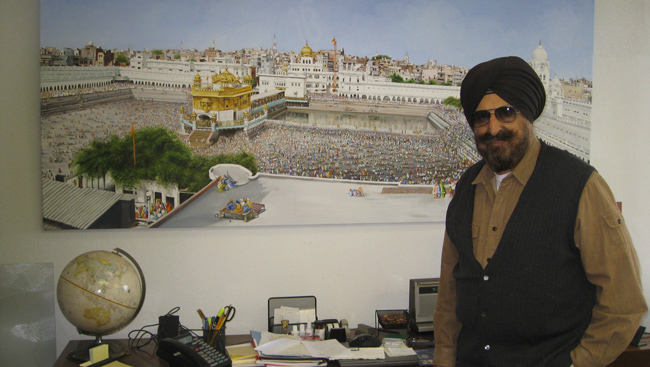
“Dr. Kapany’s early pioneering contributions are definitely the key to the success and development of the Internet,” says Dr. Waguih Ishak, vice-president and director, West Coast Research, Corning Inc.
This scientific genius hailing from Punjab, India was recognized as one of the seven ‘Unsung Heroes’ by Fortune magazine in their ‘Businessman of the Century’ issue in 1999.
Kapany is indeed a man of numerous talents and accomplishments. Throughout his life and career, he has been a scientist, inventor, entrepreneur, business executive, academic scholar, professor, mentor, philan- thropist, art collector and an artist himself.
He’s been the recipient of countless awards and recognitions, including ‘The Excellence 2000 Award’ from the USA Pan-Asian American Chamber of Commerce in 1998 and the prestigious Pravasi Bharatiya Samman, which was bestowed by the Indian government and presented by former Prime Minister Atal Bihari Vajpayee in 2004. In addition, Kapany holds over 100 patents and was a member of the National Inventors Council.
“In any discovery or invention, many people play a role and it would be wrong to say only one person did all the work. However, some people play a crucial role and show the way for further research. In the case of fiber optics, Kapany played such a critical role.
There were others, who had realized that glass cylinders or fibers could be used to transmit light, but Kapany was more successful than anybody else in solving the problems involved, and scientifically demonstrating the same,” says Shivanand Kanavi, a physicist turned author, who documented Kapany’s scientific contributions to the world in his book ‘Sand to Silicon.’ Between 1955 and 1965, Kapany was the lead researcher in the subject and published several papers on fiber optics.
The Scientist and Inventor
Born in Moga, Punjab and raised in Dehradun, Uttarakhand; Kapany had an affinity for science from a young age. It started when he was given a small Kodak camera from his father and was determined to understand its inner workings. Moreover, in his early studies, he was told by a professor that light can only travel in a straight line. Kapany thought to himself, “No, that doesn’t sound right” and took it as a challenge to prove his professor wrong. After obtaining his Bachelor of Science degree from the University of Agra, he says “there wasn’t enough to learn in India at that time so I left for Imperial College in London.” Transitioning from university in India to London was not a difficult feat for Kapany, as he says “I was young and ready to conquer the world!”
His knowledge on technology started in India while working in an ordnance factory, where he learned how to design and manufacture optical instruments. Wanting to learn more about technology at a higher level, Kapany’s intended goal was to finish his degree at The Imperial College of Science, Technology and Medicine in London and then head back to India to start his own business. The idea of having his own business and being an entrepreneur was something instilled in him from a young age.
While completing his studies, he received a scholarship from The Royal Society of Engineering to do further research into fiber optics. After 18 months and several published articles, Kapany had success-fully completed his objective of demonstrating the transmission of light and images through glass fibers. Upon the completion of his work, Kapany presented his findings to his professor and at that point was ready to head back to India.
Highly impressed with Kapany’s research, his professor convinced both the University of London’s senate to approve Kapany for entry into the PhD program and for Kapany to stay in London to start writing his thesis. “At the time, I was totally unimpressed with the concept of having a PhD. Now I realize that I was totally wrong in that thought.”
After earning his PhD, Kapany presented his first publication on fiber optics at a conference in Florence, Italy. Soon thereafter, he was approached by a professor from the University of Rochester, who convinced him to travel to the United States and become a professor at this university, as opposed to travelling back to India. That is when Kapany’s life began in the United States, where he has been for the last 58 years making a home for his family and himself in California’s Bay Area. After Rochester, Kapany continued his research and teaching at the Illinois Institute of Technology, then he moved his family west to California.
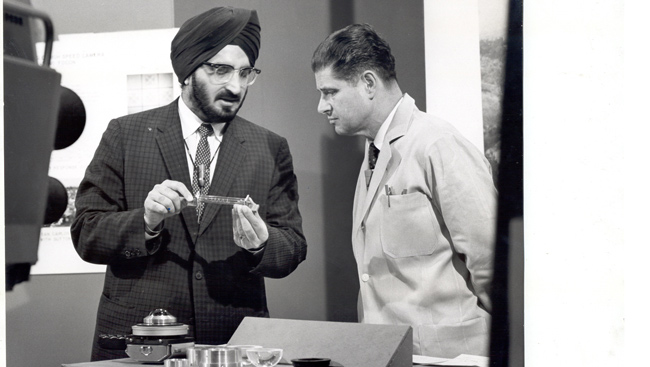
Kapany is a distinguished fellow of numerous scientific societies, including the British Royal Academy of Engineering, the Optical Society of America and the American Association for the Advancement of Science.
A Man of Different Hats
As Kapany always had the entrepreneurial spirit, it was no surprise that he established his first business in 1960 known as ‘Optics Technology Inc.’ He served as the Chairman of the Board, President and Director of Research for this company and says “We came up with phenomenal new products and took the company public in 1967, then I sold it in 1973.” Following this, he founded several other businesses, which focused on science, innovation and technology, including his most recent endeavour ‘K2 Optronics.’ He reflects back on the high-tech businesses and says “they were all well established and successful. They have all been sold now, so I’m a free man,” he jokes.
Reflecting over his years as an entrepreneur and business executive, Kapany offers advice for aspiring young entrepreneurs: “I think persistence is extremely important, and be able to forget the mistakes you’ve made. I mean you can’t carry them with you all the time – learn to do better. Other important things for entrepreneurs are mentors – you need very high-quality mentors. I have had a number in India, England and America. Lastly, the quality of people you work with, they inherently make you that much better.”
Another few hats donned by Kapany is that of scholar, author and educator. He has published over 150 scientific papers, written four books on entrepreneurship and opto-electronics and taught at numerous reputable institutions in the State of California, including University of California, Berkeley; Stanford University; and the University of California, Santa Cruz.
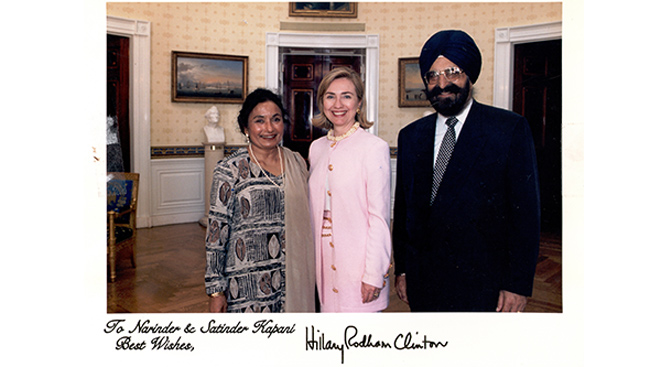
As an art enthusiast, Kapany himself dabbled in the artistry world and created ‘dynoptic’ sculptures in the late 1960s. It started when one of Kapany’s employees, who was using a fiber drawing machine that Kapany had invented, had an accident and ended up bending the glass rod. The employee threw it in the trash and when Kapany saw the bent glass rod, he thought to himself, “My god, this is art. So I took it home and ended up adding several other pieces to it.” He went on to create 50 dynoptic sculptures and was approached by Frank Oppenheimer (American physicist, professor and founder of Exploratorium), who obtained Kapany’s permission to display his art project at the Exploratorium, museum of science, life and human perception, in San Francisco in 1972.
When asked ‘Throughout your life, you have worn many different hats from scientist and inventor to entrepreneur and philanthropist, why do you think it’s important for individuals to not categorize themselves and to try different avenues in life?”
He explains that it is “exceedingly important” for individuals to wear different hats in their lifetime. “When you look at the span of human life, individuals peak at different particular areas, some peak in science, others at art, but look at Leonardo Da Vinci, he peaked in these fields and beyond. Human beings are not just one person, but capable of doing a number of things.”
He goes on to discuss his artistic endeavours, in particular his sculpture work that spanned 50 diverse sculptures, some even quite large in size, he fondly recalls. Kapany’s first exhibit, just so happened to be showcased after the conclusion of a Da Vinci exhibit, a feat in itself, and a number of museums went on to showcase Kapany’s work in the 1970/80’s.
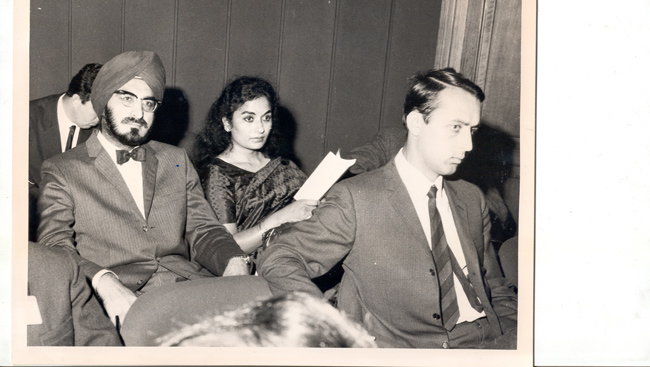
The Sikh Foundation and Philanthropy
Further notable undertakings include Kapany’s many philanthropic contributions to the areas of education and art. In 1967, he created ‘The Sikh Foundation,’ a non-profit and non-political charitable organization dedicated to promoting the culture, heritage and future of Sikhism. “I wanted to provide a platform for our children and other Americans to learn and find out what Sikhism is about.”
It was naturally inherent for Kapany to create The Sikh Foundation because his family has been involved with charity and philan- thropy work for decades, as it’s important for them to give back to local and global communities. He remembers his father fondly, and says while living in Dehradun, his father, along with a few friends, created the Guru Nanak Public School to provide free education for children. The school was very popular and what started out as a primary school, soon evolved to a middle and high school to eventually two colleges, one for men and the other for women. His father remained part of the school’s evolution and even at the age of 94, stayed on as a honourary manager of the two colleges.
The Sikh Foundation strives to foster awareness and greater ties between Sikhs and Americans in the 21st century, says Kapany and over the last few decades, the Foundation has been involved in a number of initiatives from academic courses and conferences to Sikh art exhibitions and the renovation and conservation of historical Sikh monuments.
The Foundation recently restored the mosque, which Guru Hargobind ji had built in the 1600’s for local Muslims in Punjab. Kapany explains the mosque was “in a decrepit state,” and the Foundation, along with UNESCO, renovated the mosque and “gave it back to local Muslim leaders in the area to foster cross religious and ethnic ties.”
In keeping with his philanthropic mandate, Kapany has endowed a chair of Sikh Studies, under his mother's name Kundan Kaur Kapany, at UC Santa Barbara and a chair of Opto-Electronics, and most recently a chair of Entrepreneurship, at UC Santa Cruz. Moreover, Kapany has avidly collected Sikh art and artefacts over the last few decades and in 1999, he donated $500,000 US and 100 Sikh artefacts from his personal collection to the Asian Art Museum in San Francisco.
“People didn’t realize there is such a thing as Sikh art, and there is a prodigious amount of this work that the world didn’t realize existed,” says Kapany. “It’s a treat to have this collection and to share the beauty of our culture, not only with our community and youth, but with the world at large.”
Family, Reflection and Legacy
Kapany has been married to his lovely wife Satinder since 1954. They were married in London at the Shepherd’s Bush Gurdwara, now known as Central Gurdwara (Khalsa Jatha), which was donated by Maharaja Bhupindra Singh of Patiala, says Kapany adding “this was the only Gurdwara that existed in those days, and it was the only temple in all of Europe and the United States.”
They have two children; their son Rajinder is a high-tech executive, while their daughter Kiran is a lawyer. Kapany also has four grandchildren, three of whom are at university and the youngest will be heading to university next year. You can hear the pride in his voice, as he discusses his family, especially his grandchildren, who he is very fond of.
Over Kapany’s rich life across three continents, he has met a number of remarkable individuals from dignitaries to revolutionaries, and he shares some of his favourite encounters with us, starting off with Mahatma Gandhi, whom he met as a young boy and says it was a “fascinating experience.” He went on to meet Jawaharlal Nehru and other prominent Indians, including his personal friends Maharaja Yadavindra Singh and now his son, Maharaja Amarinder Singh of Patiala.
In England, he witnessed Queen Eliza- beth’s coronation in 1953 and has met Prince Philip and son Prince Charles. He is fairly active in American social circles, and fondly remembers encounters with former President Bill Clinton and his wife Hilary, former Secretary of State. He continues to travel to India every year and during one of his recent trips, he had drinks with renowned novelist and journalist Khushwant Singh.
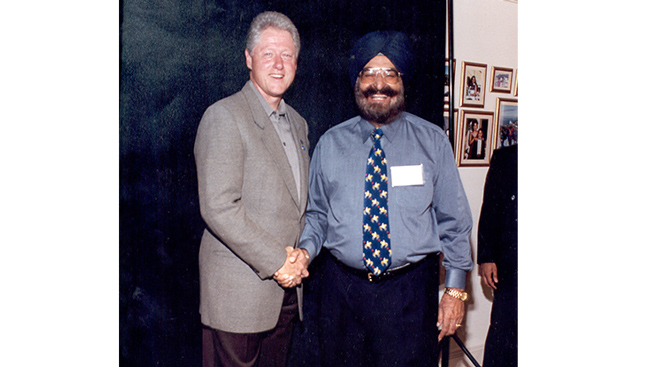
Kapany is now 85 years old, but is still extremely active and in his spare time, he is still involved in a number of business and charity endeavours, including the Sikh Foundation, but “most importantly, is to travel and have fun around the world,” he adds.
As our interview was coming to an end, we wanted to know, ‘What would you like your legacy to be for decades to come?’ “That’s a very good question, I don’t think I have focused on that,” he said with a laugh. Then he took some time to answer, “The important thing is to be a man of the world, that’s what I have tried to be, and to a small extent succeeded, but I like to do things for people.
I want to help people develop themselves and other aspects of their lives. I used to teach entrepreneur courses at the University of California in the 1970/80’s, and my pupils are now CEO’s and President’s of their own companies – I enjoy that. They now come over and buy me lunch, and tell me about all the wonderful things they are doing and that’s great.” We both confer that it’s amazing to see how life comes around in full circle.
Dr. Narinder Kapany, a name that should be synonymous with other great contributors to technology and science like Bill Gates and Steve Jobs, gave the world fiber optics. A brilliant yet humble visionary, who has countless life lessons to offer and an infectious laugh that brings a beaming smile to anyone within earshot.
His dedication and commitment to his research and fellow man has helped shape the very nature of our world today. Without his efforts, the world would have been dull with shades of black, grey and white; instead we see it in a myriad of colours and waves. If you are told to believe something, even though it doesn’t sit right with you, don’t take it for its face value. Go out and try to disprove it. You just may in fact be responsible for the next great invention to affect our lives and change our world for the better.

